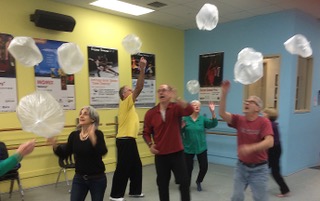Parkinson’s Pantomime Project
The Parkinson’s Pantomime Project (PD Mime) explores methods of training in specific motor skills adapted from the techniques of pantomime and circus to modify or alleviate symptoms of idiopathic PD. One goal of the PD Mime classes is to trigger the Paradoxical Kinesia Impulse (PKI) as a movement management strategy.
Paradoxical Kinesia is an intriguing phenomenon wherein individuals with PD-related movement difficulties suddenly perform complex movements smoothly, even though motor function had been substantially limited. What if people with PD could purposefully stimulate this phenomenon: would they demonstrate marked improvement in mobility, including gait, reflexes, balance, posture, and general coordination? Does the brain’s innate intelligence at times stimulate neuroplasticity to bypass damaged neural pathways and take alternate routes?
Applying the principles of pantomime, we may discover ways of becoming more conscious of daily movement, with the intent of adapting this awareness to counteract the symptoms of movement disorder.
— Charlotte G., Program Coordinator, Binter Center for Parkinson’s and Movement Disorders
Click here to learn more about our Mime Over Matter program.
(More PD Mime videos under the Gallery page)
“For me, having Parkinson’s is like doing mime all day.”
– Rob Mermin
Below is a RumblestripVermont audio podcast by Erica on October 16, 2017. It features Rob Mermin talking about movement, the loss of control of movement… catastrophe and grace. Included are several anecdotes about Marcel Marceau as well as Rob’s thoughts about his own Parkinson’s.
MIME (Imagination and Mental Agility)
Six Principles of PD Mime
1. Awareness
2. Observation
3. Analysis
4. Visualization
5. Pantomime
6. Intentional Movement
Six Techniques of Mime
1. Breath control
2. Body Language
3. Gesture (articulation)
4. Nonverbal Communication (NVC)
5. Rhythm and Movement Dynamics
6. Creative use of Imagery and Space
CIRCUS (Spatial Awareness and Play)
Flexibility, equilibrium/balance games, and juggling. “Juggling” in this context is defined not as throwing multiple objects in the air, but as the purposeful manipulation of objects, dexterity, ambidextrous coordination of both sides of the body, and development of reflexes. Applications are for gaining confidence in handling everyday objects—dishes, toothpaste, food, clothing, etc.—while having fun with the practice!

Juggling bags can help with balance

